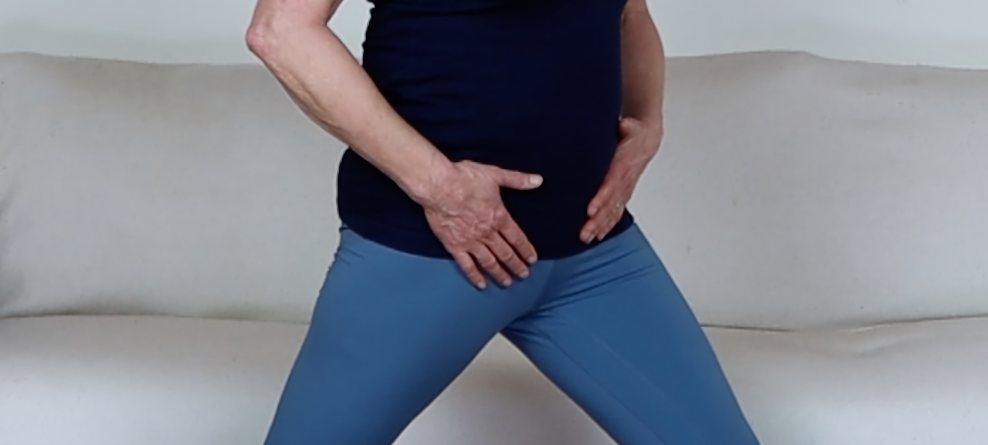
While going through total hip replacement we want tools at our disposal to support the journey both on and off the yoga mat. Blocks, bolsters, walkers, canes, and other devices help but one of the best supports is our hands!
Think of the kinds of subtle information that your hands can detect. They are able to distinguish (and read) the tiny dots on a page of braille. They can tease out whether a surface is level or not. They can chop an onion without cutting off a finger. Hands can process subtle changes in temperature and texture. And, they can provide a soothing touch. Why are our hands able to do this?
On the neurological level it is because the nerves of our hands are mapped to a large area in our brain’s primary motor cortex (the area in our brain responsible for planning and executing actions). This means that the brain receives, processes, and understands detailed information provided by our hands. And this concentrated and detailed information helps us orient and navigate the world in so many ways.
From the yogic energetic perspective, the hands are a source of concentrated energy (prana) that can be harnessed and moved in the body. In yoga, the energy associated with the hands is called hasta bandha (hand lock or arch) and it is one of 5 bandhas.* All the bandhas contain vortices of energy that can be tapped in order to move and control that energy and, when any of them are used well, this can help manage stress, calm the mind, and ease the experience of pain.
The neurological and energetic benefits of the use of our hands has implications for total hip replacement.
- The hands provide information that can help us be mindful of where our body is in space (proprioception) and whether we are aligned and whether our new hips are safe.
- The hands can energize, stabilize, and support movement while we are getting used to our new hips.
- When faced with stressors like pain we can use our hands to tap in to subtle energy for vitality and well-being.
The hands can help us find alignment.
For example, we can’t always “feel” how our pelvis is oriented in a standing pose. This is because the pelvis has a lower priority in our motor cortex. Using your hands to feel the positioning of the pelvis can help you calculate whether it is level with the ground, tilted forward or back, or twisted in relation to the rest of your body.
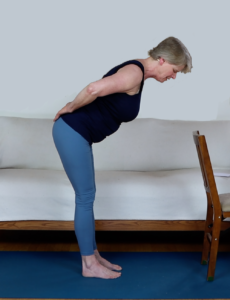
As an example, stand in Mountain Pose (Tadasana) and place both hands on the back of your pelvis. Then begin to tilt your pelvis into 1/2 Forward Fold (1/2 Uttanasana) and stop where you can hold the pose for a bit. Feel with your hands how the pelvis stays level from left to right. Hold it for a moment and take in the sensations you feel. Then return to Mountain Pose (Tadasana).
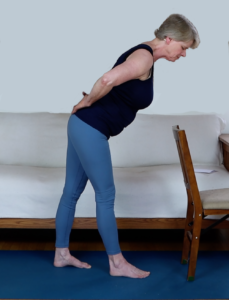
Now step one foot forward a little and the other foot back a little. Begin to tilt your pelvis forward toward Intense Side Stretch (Parsvottanasana) and stop where you can hold the pose for a bit. Feel again with your hands. Is your pelvis level? Use your hands on the back of the pelvis, remembering how it felt in Tadasana, to find level. Once level, take time to feel. As you take in the sensations of a level pelvis in this position you are mapping new neural pathways so you can find that position more easily the next time. Your hands have helped you find your pose.
Hands provide energy and stability.
Hasta Bandha provides grounding and strength.
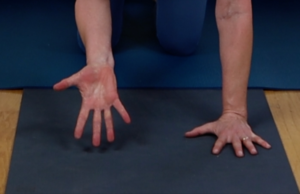
The hands provide stability for inversions …
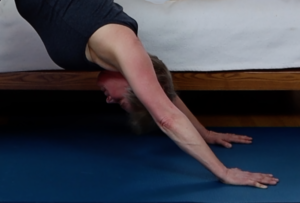
… and energize standing poses.
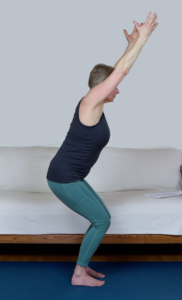
Hands help us feel safe while balancing …
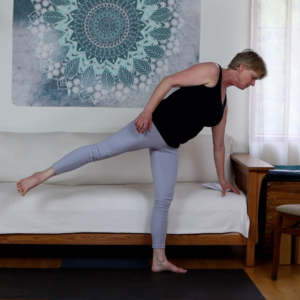
… with sometimes only the suggestion of touch required.
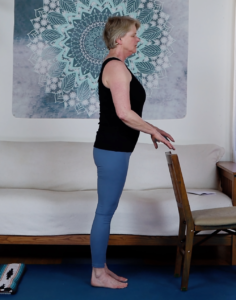
Use your hands to soothe.
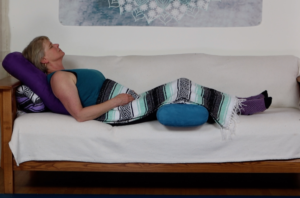 When you feel pain, try finding a comfortable position in your lounge chair or on your bed. Place your hands over the area of pain, close your eyes, and spend some time breathing and feeling the sensation of pain. Keep your hands resting on that spot. Observe the warmth of your hands, the weight of your hands. As you inhale and exhale, feel your hands move with the rise and fall of your body. This kind of gentle touch and focus of the mind promotes healing and helps manage stress.
When you feel pain, try finding a comfortable position in your lounge chair or on your bed. Place your hands over the area of pain, close your eyes, and spend some time breathing and feeling the sensation of pain. Keep your hands resting on that spot. Observe the warmth of your hands, the weight of your hands. As you inhale and exhale, feel your hands move with the rise and fall of your body. This kind of gentle touch and focus of the mind promotes healing and helps manage stress.
Homunculus – the Little Man: What he tells us about our hands and the other parts of our body
Scientists in the late 19th and early 20th century found that when they stimulated the brain with electrical impulses they noticed how different parts of the body would twitch. They created a map of the locations in the brain that corresponded to those body parts and then created a visual map of their location and relative size. The Homunculus (Little Man) depicts body parts in proportion to the relative amount of brain space that is devoted to each body part.
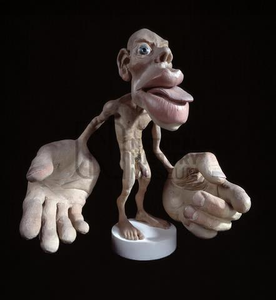
So get inventive and use your hands during your yoga practice:
-
- Use your hands to help train body parts. Sometimes our toes don’t want to move the way we want them to — like spreading them wide. Use your hands to position your toes
- Use your hands to watch your breath. Place them on your belly, then on your chest. This can raise your awareness of how you are breathing.
- Use your hands to locate where you are in space. Feel your rib cage as you twist to clarify if you are actually moving your thoracic spine vs compensating with your shoulder or hip joints.
- Place your hands on specific muscles and feel them contract or release as you move in poses. This can help you understand if you are recruiting the muscles you want to be using to support your joints.
- Do you have specific ways you use your hands in the practice? Let us know in the comments.
Here’s to Healthy and Happy Hips!
Yoga while healing from Total Hip Replacement Surgery: A safe post-op asana practice – Free video
Standing Poses Preview – Non-members
Standing Poses – Members
Become a member of Yoga for Hip Replacement here
Note: Scientist have recently discovered even deeper implications of this mapping for understanding and treating brain injuries (see links below)
* Hasta bandha is one of 5 bandhas in the body. The three major bandhas, and their approximate locations in the body are: Mula Bandha – the pelvic floor muscles. Uddiyana Bandha – the abdominals up to the diaphragm. Jalandhara Bandha – the throat. The two minor bandhas are Pada Bandha – the feet, and Hasta Bandha – the hands.
Articles and Studies:
Famous “homunculus” brain map redrawn to include complex movements
Talk to your surgeon or healthcare provider before beginning any athletic program.
Download PDF of informational flyer here
© 2021 Yoga for Hip Replacement | Privacy Policy | Terms of Use
